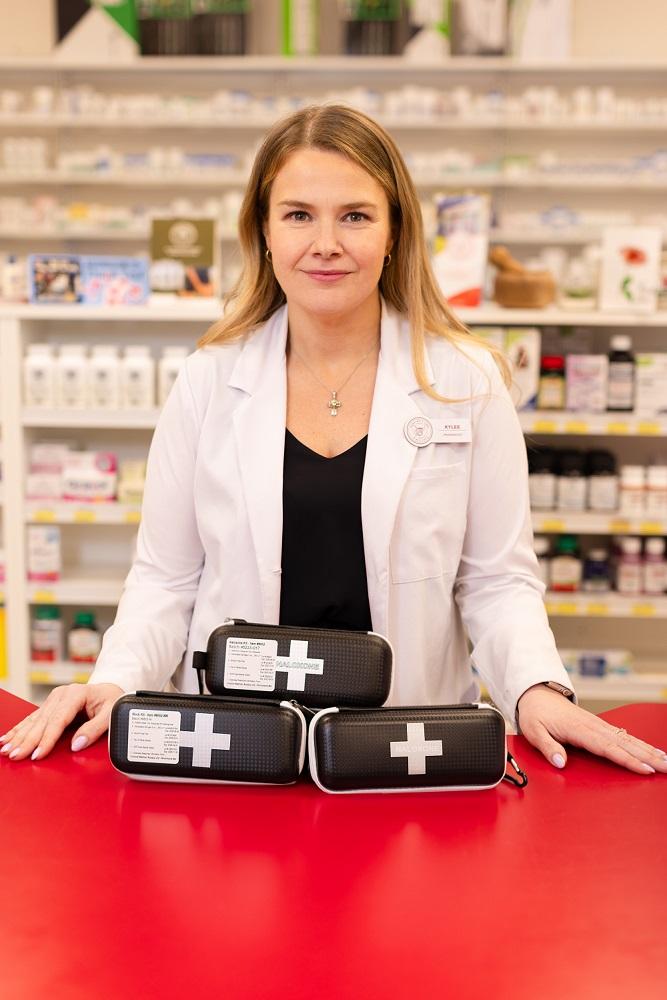By Kylee Power, BSC(Pharm)
Board Member, BCPhA

It was over in a few minutes. When I woke that day I never thought I would find myself crouched on a sidewalk in downtown Vancouver, providing breaths through a one-way face mask into the mouth of an unconscious stranger whose face was blue.
Visiting Vancouver from my hometown of Nanaimo for an event, my husband, sister, brother-in-law and I were in an unfamiliar area looking for a place to grab lunch. As we were walking, we saw a man standing with a group of others collapse. At first, in the commotion, I didn’t know what was going on. I didn’t know how I could help. When I heard someone shout for “Narcan”, I immediately knew what that meant. Someone was experiencing a possible overdose. They were in danger. As a pharmacist, I knew how to help.
In British Columbia, hundreds of community pharmacies participate in the Take Home Naloxone program, including the seven pharmacies owned and operated by my group, The Central Drugs Stores Ltd. As a member of this program, I was familiar with naloxone, commonly called Narcan® — one of its brand names. I knew what it was for, how to use it, and I felt prepared for what came next.
It was Jan. 28, 2024. It was supposed to be a fun trip to Vancouver. I never would have thought that, on this particular day, our decision to be part of the Take Home Naloxone program — and to receive the training that came with it — would help save a life.
I immediately dialed 911. I said “ambulance” to the voice on the other end and handed the phone to my husband to provide our location. My attention was on the person in front of me. I told those gathered around that I am a pharmacist and asked if we could help.
While some of his group scattered, those who remained with him had managed to administer a first dose of naloxone but due to physical limitations, they were unable to reposition him, check his airway, or provide breaths. Upon turning him over, we found him completely blue, unresponsive to stimulus, and not breathing. But he had a pulse. There was hope.

About 900 pharmacies participate in the Take Home Naloxone program in B.C., where the public can go to pick up a naloxone kit such as this.
With the training I had completed through the Toward the Heart program, and with the guidance of the emergency services operator, we used the supplies in a naloxone kit to respond. Inside, in addition to the naloxone, the kit contains a one-way valve mask. With that device I began providing respirations while another prepared the second and ultimately third of naloxone for me to administer. Everything we needed to safely respond came from a naloxone kit that a bystander had on them, the same kind that we give out at the pharmacy.
I cannot begin to describe the relief I felt when suddenly, he took a deep gasp, and colour began returning to his face. Paramedics soon arrived on the scene and assumed command. They confirmed he had a pulse, provided oxygen, and told us they would take over from there.
This incident left a lasting impression on me. It became real to me that every naloxone kit that leaves our store has the potential to save someone’s life. There’s a chance that the same kit that was used on this person came from a community pharmacy like mine. I am thankful that I recognized it as any one of the kits I have at my own store and felt confident using the supplies inside.
There are approximately 1,500 community pharmacies in B.C., but fewer than 900 of them currently participate in the Take Home Naloxone program. That means there are potentially 600 pharmacies in B.C. where someone might visit, hoping that they could pick up a naloxone kit, but are turned away because the pharmacy doesn’t stock them. While community pharmacies make up the majority of the over 1300 registered Take Home Naloxone distribution sites, we can still do better.
For my business partners and myself, the decision to register our stores in the program was simple. We didn’t want anyone seeking a kit to be turned away empty handed. We wanted to help.
There is no fee for distributing naloxone kits, and I know that this can be a barrier for some pharmacy owners, but I urge you to please consider the impact your participation could make on someone’s life.
